A House in the Country / Me Needing You (1966)
A House in the Country / Me Needing You est le septième 45 tours des Pretty Things, sorti en juillet 1966.
A House in the Country / Me Needing You est le septième 45 tours des Pretty Things, sorti en juillet 1966.
Come See Me / £.s.d. est le sixième 45 tours des Pretty Things, sorti en avril 1966.
Après l’échec de Midnight to Six Man, les Pretties se rabattent sur une reprise pour leur 45 tours suivant. Dans la presse britannique, les critiques applaudissent l’énergie débridée de Come See Me, à l’exception notable de Penny Valentine de Disc & Music Echo qui regrette le son sale adopté par le groupe.
C’est évidemment la face B qui fait parler d’elle avec son titre ambigu, sans que la controverse n’enflamme particulièrement la presse.
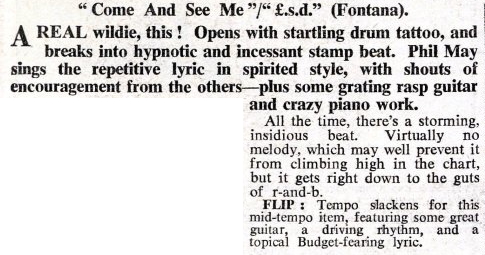
A real wildie, this! Opens with startling drum tattoo, and breaks into hypnotic and incessant stamp beat. Phil May sings the repetitive lyric in spirited style, with shouts of encouragement from the others—plus some grating rasp guitar and crazy piano work.
All the time, there’s a storming, insidious beat. Virtually no melody, which may well prevent it from climbing high in the chart, but it gets right down to the guts of r-and-b.
FLIP: Tempo slackens for this mid-tempo item, featuring some great guitar, a driving rhythm, and a topical Budget-fearing lyric.
Derek Johnson, NME, 22 avril 1966
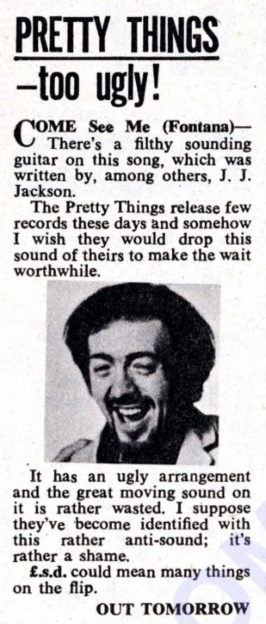
Come See Me (Fontana)—There’s a filthy sounding guitar on this song, which was written by, among others, J. J. Jackson.
The Pretty Things release few records these days and somehow I wish they would drop this sound of theirs to make the wait worthwhile.
It has an ugly arrangement and the great moving sound on it is rather wasted. I suppose they’ve become identified with this rather anti-sound; it’s rather a shame.
£.s.d. could mean many things on the flip.
Penny Valentine, Disc & Music Echo, 23 avril 1966
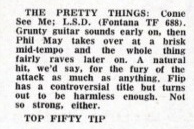
THE PRETTY THINGS: Come See Me; L.S.D. (Fontana TF 688). Grunty guitar sounds early on, then Phil May takes over at a brisk mid-tempo and the whole thing fairly raves later on. A natural hit, we’d say, for the fury of the attack as much as anything. Flip has a controversial title but turns out to be harmless enough. Not so strong, either.
Record Mirror, 23 avril 1966
Au Royaume-Uni, Come See Me est resté cinq semaines dans le Top 50 des ventes établi par le magazine Record Retailer, sans dépasser la 43e place. Le single fait un peu mieux dans les classements rivaux de Disc (38e) et Melody Maker (35e).
| Date | Position (Record Retailer) | Position (Melody Maker) | Position (Disc) |
|---|---|---|---|
| 30 avril 1966 | — | — | 47 |
| 7 mai 1966 | 44 | — | 47 |
| 14 mai 1966 | 46 | 50 | — |
| 21 mai 1966 | 46 | 38 | 46 |
| 28 mai 1966 | 44 | 36 | — |
| 4 juin 1966 | 43 | 35 | 38 |
| 11 juin 1966 | — | — | 50 |
| source | source | source |
← Single précédent : Midnight to Six Man / Can’t Stand the Pain
Single suivant : A House in the Country / Me Needing You →
Midnight to Six Man / Can’t Stand the Pain est le cinquième 45 tours des Pretty Things, sorti en décembre 1965.
C’est le premier enregistrement paru du groupe avec Skip Alan, qui a remplacé Viv Prince à la batterie un mois auparavant.
Pour la face A, les Pretties sont accompagnés de deux claviéristes. Le premier est le légendaire musicien de studio Nicky Hopkins, plus connu pour avoir joué avec les Rolling Stones et les Kinks (Ray Davies lui a même dédié une chanson, Session Man). L’autre est Margo Croccito, l’organiste de Goldie and the Gingerbreads, l’un des tout premiers groupes de filles de l’histoire du rock.
La presse musicale britannique accueille avec un grand enthousiasme ce 45 tours. Même Penny Valentine de Disc, rarement convaincue par les disques des Pretty Things, n’a que de bonnes choses à dire sur Midnight to Six Man dont elle apprécie tout particulièrement les paroles. Pour Derek Johnson, l’atmosphère pleine d’énergie compense largement la mélodie un peu faible et à ses yeux, c’est le seul tube en puissance sorti en cette toute fin d’année 1965. Record Mirror promet également au disque un bel avenir au hit-parade britannique, tout comme Cash Box de l’autre côté de l’Atlantique, des prédictions qui ne se réaliseront hélas pas.
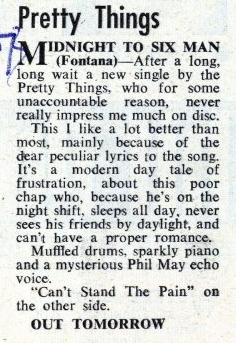
After a long, long wait a new single by the Pretty Things, who for some unaccountable reason, never really impress me much on disc.
This I like a lot better than most, mainly because of the dear peculiar lyrics to the song. It’s a modern day tale of frustration, about this poor chap who, because he’s on the night shift, sleeps all day, never sees his friends by daylight, and can’t have a proper romance.
Muffled drums, sparkly piano and a mysterious Phil May echo voice.
“Can’t Stand the Pain” on the other side.
Penny Valentine, Disc Weekly, 18 décembre 1965
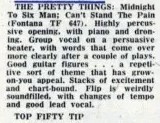
Highly percussive opening, with piano and droning. Group vocal on a persuasive beater, with words that come over more clearly after a couple of plays. Good guitar figures . . . a repetitive sort of theme that has grow-on-you appeal. Stacks of excitement and chart-bound. Flip is weirdly soundfilled, with changes of tempo and good lead vocal.
Record Mirror, 18 décembre 1965
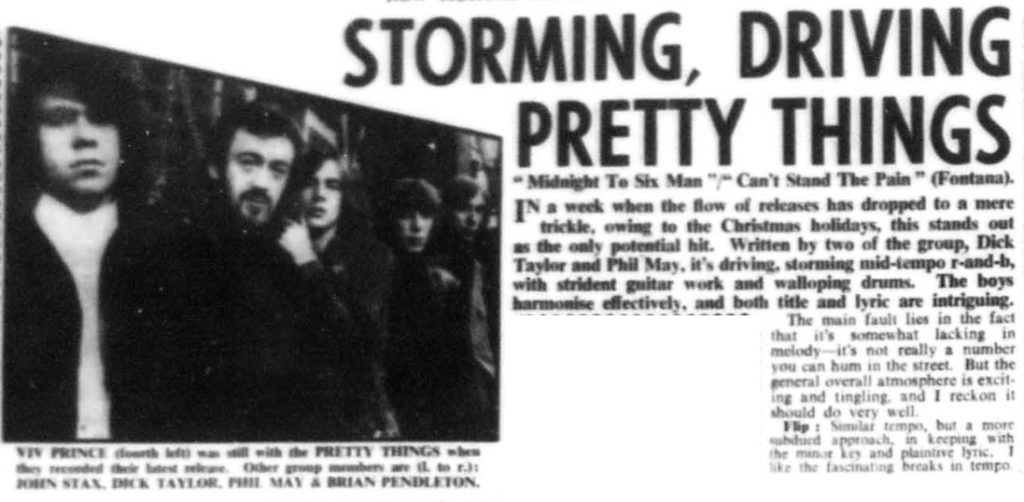
In a week when the flow of releases has dropped to a mere trickle, owing to the Christmas holidays, this stands out as the only potential hit. Written by two of the group, Dick Taylor and Phil May, it’s driving, storming mid-tempo r-and-b, with strident guitar work and walloping drums. The boys harmonise effectively, and both title and lyric are intriguing.
The main fault lies in the fact that it’s somewhat lacking in melody—it’s not really a number you can hum on the street. But the general overall atmosphere is exciting and tingling, and I reckon it should do very well.
Flip: Similar tempo, but a more subdued approach, in keeping with the minor key and plaintive lyric. I like the fascinating breaks in tempo.
Derek Johnson, NME, 24 décembre 1965
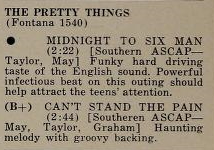
MIDNIGHT TO SIX MAN (2:22) [Southern ASCAP—Taylor, May] Funky hard driving taste of the English sound. Powerful infectious beat on this outing should help attract the teens’ attention.
(B+) CAN’T STAND THE PAIN (2:44) [Southeren ASCAP—May, Taylor, Graham] Haunting melody with groovy backing.
Cash Box, 19 février 1966
Malgré l’enthousiasme des critiques, le public boude Midnight to Six Man. Il ne figure qu’une toute petite semaine dans le Top 50 des meilleures ventes établi par le magazine Record Retailer et s’en sort à peine mieux dans le classement rival du New Musical Express, avec trois semaines dans les charts. Il ne réussit même pas à entrer dans les classements de Disc et Melody Maker.
| Date | Position (Record Retailer) | Position (NME) |
|---|---|---|
| 8 janvier 1966 | — | 27 |
| 15 janvier 1966 | — | 27 |
| 22 janvier 1966 | — | — |
| 29 janvier 1966 | 46 | 26 |
| source | source |
← Single précédent : Cry to Me / Get a Buzz
Single suivant : Come See Me / £. s. d. →
Cry to Me / Get a Buzz est le quatrième 45 tours des Pretty Things. Il est sorti le 25 juin 1965 chez Fontana Records.
Les Pretties affirment a posteriori ne pas avoir su que les Rolling Stones avaient enregistré au même moment une reprise de cette chanson de Solomon Burke pour leur album Out of Our Heads. Qu’il s’agisse effectivement d’une coïncidence ou pas, la parution presque simultanée des deux versions n’a pas dû aider à mettre un terme aux comparaisons entre les deux groupes.
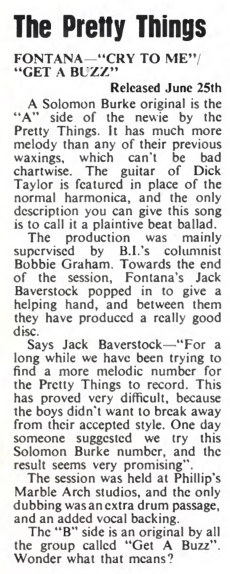
A Solomon Burke original is the “A” side of the newie by the Pretty Things. It has much more melody than any of their previous waxings, which can’t be bad chartwise. The guitar of Dick Taylor is featured in place of the normal harmonica, and the only description you can give this song is to call it a plaintive beat ballad.
The production was mainly supervised by B.I.’s columnist Bobbie Graham. Towards the end of the session, Fontana’s Jack Baverstock popped in to give a helping hand, and between them they have produced a really good disc.
Says Jack Baverstock—“For a long while we have been trying to find a more melodic number for the Pretty Things to record. This has proved very difficult, because the boys didn’t want to break away from their accepted style. One day someone suggested we try this Solomon Burke number, and the result seems very promising”.
The session was held at Phillip’s Marble Arch studios, and the only dubbing was an extra drum passage, and an added vocal backing.
The “B” side is an original by all the group called “Get A Buzz”. Wonder what that means?
Beat Instrumental, juillet 1965
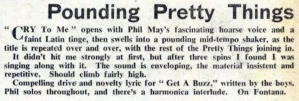
“Cry To Me” opens with Phil May’s fascinating hoarse voice and a faint Latin tinge, then swells into a pounding mid-tempo shaker, as the title is repeated over and over, with the rest of the Pretty Things joining in.
It didn’t hit me strongly at first, but after three spins I found I was singing along with it. The sound is enveloping, the material insistent and repetitive. Should climb fairly high.
Compelling drive and novelty lyric for “Get A Buzz,” written by the boys. Phil solos throughout, and there’s a harmonica interlude. On Fontana.
Derek Johnson, New Musical Express, 2 juillet 1965
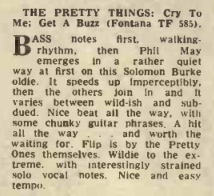
Bass notes first, walking-rhythm, then Phil May emerges in a rather quiet way at first on this Solomon Burke oldie. It speeds up imperceptibly, then the others join in and it varies between wild-ish and subdued. Nice beat all the way, with some chunky guitar phrases. A hit all the way… and worth the waiting for. Flip is by the Pretty Ones themselves. Wildie to the extreme, with interestingly strained solo vocal notes. Nice and easy tempo.
Norman Jopling et Peter Jones, Record Mirror, 3 juillet 1965
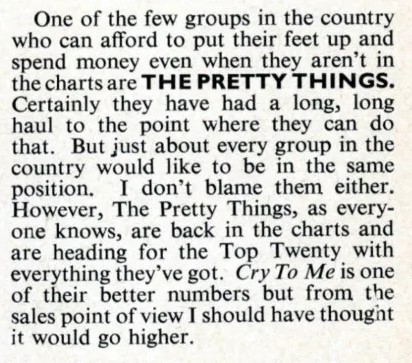
One of the few groups in the country who can afford to put their feet up and spend money even when they aren’t in the charts are THE PRETTY THINGS. Certainly they have had a long, long haul to the point where they can do that. But just about every group in the country would like to be in the same position. I don’t blame them either. However, The Pretty Things, as everyone knows, are back in the charts and are heading for the Top Twenty with everything they’ve got. Cry To Me is one of their better numbers but from the sales point of view I should have thought it would go higher.
Don Crisp, Pop Weekly, 7 août 1965
Au Royaume-Uni, Cry to Me est resté sept semaines dans le Top 50 des meilleures ventes établi par le magazine Record Retailer, avec un pic à la 28e place. Il fait un peu mieux dans le classement concurrent du New Musical Express, où il entre de justesse dans le Top 20.
| Date | Position (Record Retailer) | Position (NME) | Position (Melody Maker) | Position (Disc) |
|---|---|---|---|---|
| 10 juillet 1965 | — | 25 | 45 | — |
| 17 juillet 1965 | 34 | 20 | 42 | — |
| 24 juillet 1965 | 28 | 20 | 33 | 26 |
| 31 juillet 1965 | 31 | 26 | 33 | 29 |
| 7 août 1965 | 34 | 27 | 34 | — |
| 14 août 1965 | 32 | — | 39 | — |
| 21 août 1965 | 37 | — | 44 | — |
| 28 août 1965 | 41 | — | — | — |
| 4 septembre 1965 | — | — | — | — |
| source | source | source | source |
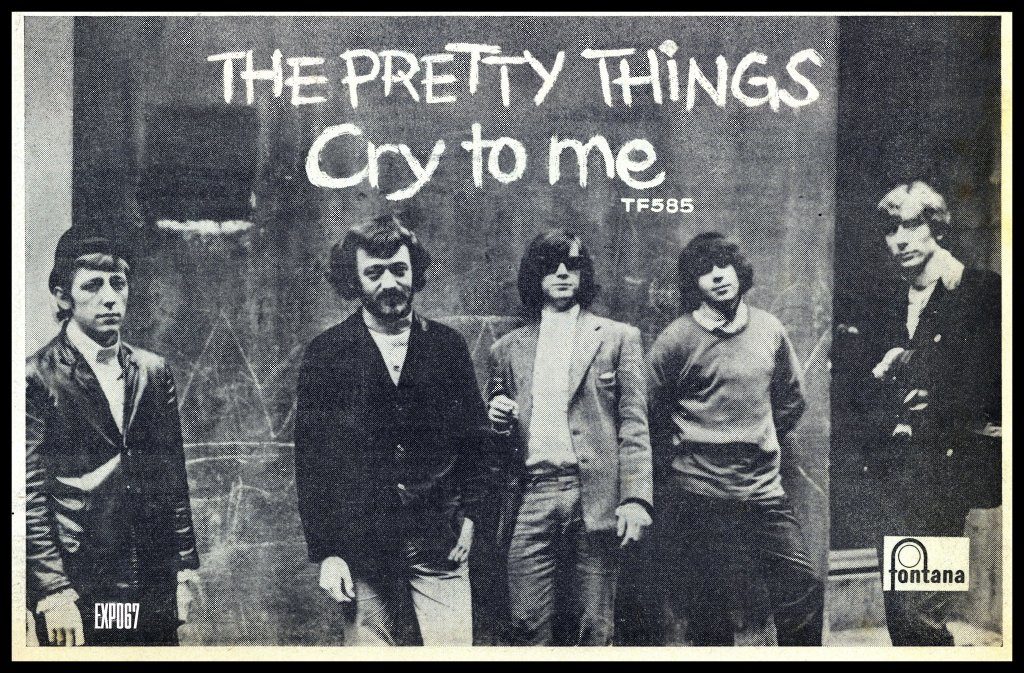
← Single précédent : Honey, I Need / I Can Never Say
Single suivant : Midnight to Six Man / Can’t Stand the Pain →
Honey, I Need / I Can Never Say est le troisième 45 tours des Pretty Things. Il est sorti le 12 février 1965 au Royaume-Uni.
C’est la première fois qu’une face A est créditée à un membre du groupe, en l’occurrence Dick Taylor (avec quelques amis). La face B est quant à elle la première chanson créditée aux cinq Pretty Things.
Le single reçoit un accueil contrasté. Dans Disc Weekly, Penny Valentine déplore la brutalité de la production (« on dirait qu’ils chantent depuis l’intérieur d’un baril… tellement d’écho que le disque a presque rebondi hors de la platine »), tandis que Peter Jones salue l’efficacité du son des Pretties dans Record Mirror. La critique laconique de Melody Maker y voit un effort « crassement commercial » qui devrait quand même bien se vendre.
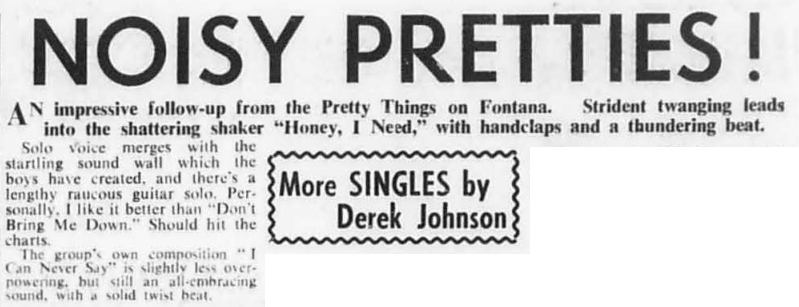
Noisy Pretties! An impressive follow-up from the Pretty Things on Fontana. Strident twanging leads into the shattering shaker “Honey, I Need,” with handclaps and a thundering beat.
Solo voices merges with the startling sound wall which the boys have created, and there’s a lengthy raucous guitar solo. Personally, I like it better than “Don’t Bring Me Down.” Should hit the charts.
The group’s own composition “I Can Never Say” is slightly less overpowering, but still an all-embracing sound, with a solid twist beat.
Derek Johnson, New Musical Express, 12 février 1965
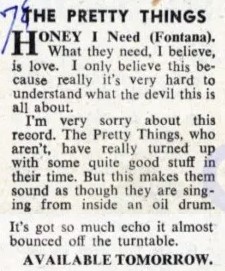
What they need, I believe, is love. I only believe this because really it’s very hard to understand what the devil this is all about.
I’m very sorry about this record. The Pretty Things, who aren’t, have really turned up with some quite good stuff in their time. But this makes them sound as though they are singing from inside an oil drum.
It’s got so much echo it almost bounced off the turntable.
Penny Valentine, Disc Weekly, 13 février 1965
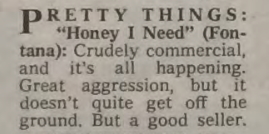
Crudely commercial, and it’s all happening. Great aggression, but it doesn’t quite get off the ground. But a good seller.
Melody Maker, 13 février 1965
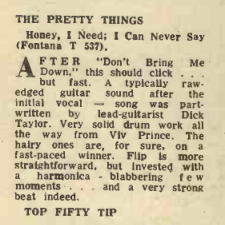
After “Don’t Bring Me Down,” this should click… but fast. A typically raw-edged guitar sound after the initial vocal—song was part-written by lead-guitarist Dick Taylor. Very solid drum work all the way from Viv Prince. The hairy ones are, for sure, on a fast-paced winner. Flip is more straightforward, but invested with a harmonica-blabbering few moments… and a very strong beat indeed.
Peter Jones, Record Mirror, 13 février 1965
Au Royaume-Uni, Honey, I Need est resté dix semaines dans le hit-parade établi par le magazine Record Retailer, avec un pic à la 13e place. Il réalise des performances légèrement meilleures dans les classements concurrents du New Musical Express (10e), Melody Maker et Disc (12e).
| Date | Position (Record Retailer) | Position (NME) | Position (Melody Maker) | Position (Disc) |
|---|---|---|---|---|
| 20 février 1965 | — | 25 | — | — |
| 27 février 1965 | 32 | 18 | 36 | 30 |
| 6 mars 1965 | 21 | 18 | 20 | 20 |
| 13 mars 1965 | 19 | 14 | 19 | 16 |
| 20 mars 1965 | 13 | 11 | 12 | 12 |
| 27 mars 1965 | 18 | 10 | 12 | 17 |
| 3 avril 1965 | 25 | 18 | 23 | 18 |
| 10 avril 1965 | 23 | — | 26 | 28 |
| 17 avril 1965 | 37 | — | 35 | — |
| 24 avril 1965 | 28 | — | 38 | — |
| 1er mai 1965 | 45 | — | 48 | — |
| source | source | source | source |
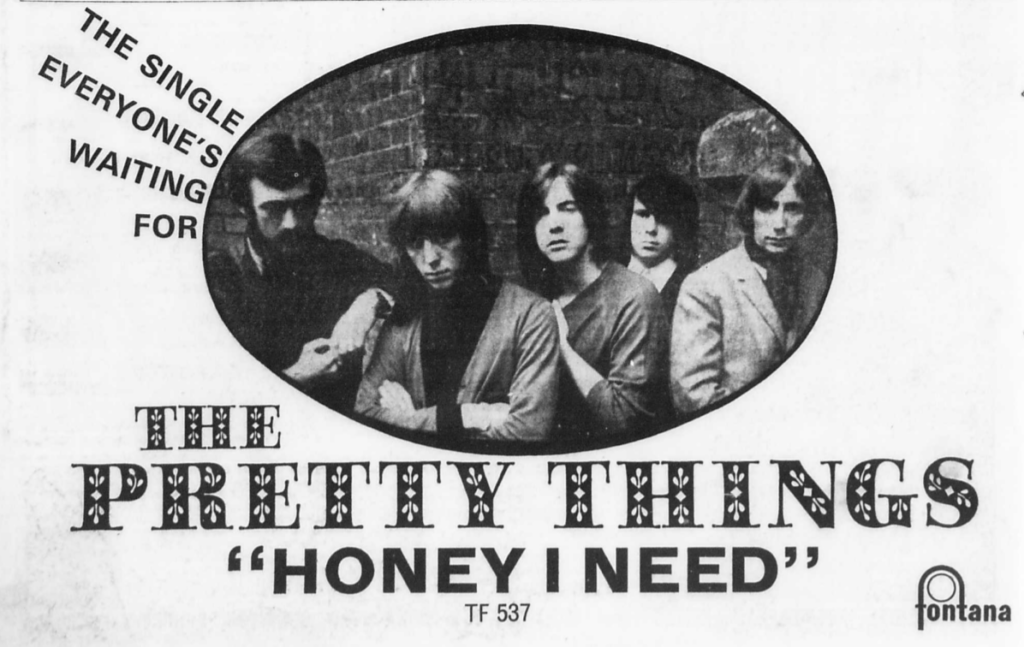
← Single précédent : Don’t Bring Me Down / We’ll Be Together
Single suivant : Cry to Me / Get a Buzz →
Don’t Bring Me Down / We’ll Be Together est le deuxième 45 tours des Pretty Things, sorti en octobre 1964.
La face B, We’ll Be Together, est la première chanson composée par des membres du groupe à apparaître sur un disque.
Le single est encore mieux accueilli que Rosalyn par la presse musicale britannique. Dans Disc, Don Nicholl prédit à juste titre qu’il permettra au groupe de faire son entrée dans le Top 20 des ventes grâce à la force de la voix de Phil May et à l’enthousiasme des musiciens qui l’accompagnent. Beat Instrumental fait la même prédiction et Record Mirror est tout aussi enthousiaste, sans parvenir à s’empêcher d’avoir recours à la déjà sempiternelle comparaison avec les Rolling Stones. Le magazine américain Cash Box envisage que ce disque leur permette de percer sur le marché U.S., ce qui n’aura en fin de compte pas lieu.
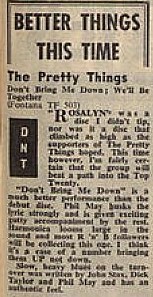
“Rosalyn” was a disc I didn’t tip, nor was it a disc that climbed as high as the supporters of The Pretty Things hoped. This time however, I’m fairly certain that the group will beat a path into the Top Twenty.
“Don’t Bring Me Down” is a much better performance than the debut disc. Phil May barks the lyric strongly and is given exciting party accompaniment by the rest. Harmonica looms large in the sound and most R ‘n’ B followers will be collecting this one. I think it’s a case of a number bringing them UP, not down.
Slow, heavy blues on the turn-over was written by John Stax, Dick Taylor and Phil May and has an authentic feel.
Don Nicholl, Disc, 17 octobre 1964
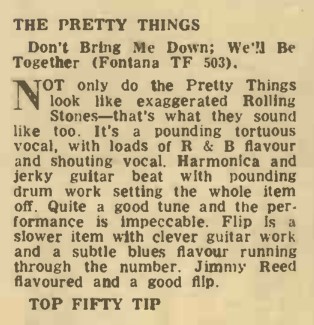
Not only do the Pretty Things look like exaggerated Rolling Stones—that’s what they sound like too. It’s a pounding tortuous vocal, with loads of R & B flavour and shouting vocal. Harmonica and jerky guitar beat with pounding drum work setting the whole item off. Quite a good tune and the performance is impeccable. Flip is a slower item with clever guitar work and a subtle blues flavour running through the number. Jimmy Reed flavoured and a good flip.
Record Mirror, 17 octobre 1964
On tour, the Pretty Things whip up enormous enthusiasm. The only surprise is that they’ve waited so long for this follow-up to “Rosalyn,” their debut—which hit the charts. Trouble has been finding the right material… and this top side was penned by Johnny Dee, ex-singer of the Bulldogs, who travelled with the “Things,” soaking up their own individual sort of atmosphere.
Treatment shows signs of similarity to a Rolling Stones production, but this may not be a handicap. Phil May’s violently husky vocal work is quite exceptional, flexible and dynamic. The R & B “feel” comes through well enough… well enough to give it a chart placing. Flip, on the other hand, features slow and ponderous blues motifs, with a thoroughly way-out approach all the way. Taken on the strength of both sides, this release adds considerably to the boys’ “Rosalyn” reputation.
The session was handled by drummer-arranger Bobby Graham with Fontana recording manager Jack Baverstock. Says Jack: “I believe this will be the one to get the boys really big acceptance. They’re excited and authentic. No trouble on the recording—it was in the can after just five ‘takes’.”
Could be a pretty good seller for the Pretty Things.
Beat Instrumental, novembre 1964

The Pretty Things, the hot new English group with what looks like the longest hair of ‘em all, can break thru in the U.S. with outing on the Fontana label. Artists carve out a rockin’ r&b-styled handclapper, tagged “Don’t Bring Me Down,” in heartfelt earthy-blues style. Backing’s a slop paced blueser dubbed “We’ll Be Together.”
Cash Box, 7 novembre 1964
Au Royaume-Uni, Don’t Bring Me Down est resté onze semaines dans le hit-parade établi par le magazine Record Retailer, avec un pic à la 10e place. Il s’agit de la meilleure performance de l’histoire du groupe. Dans le classement rival du New Musical Express, le single atteint même la huitième position. En revanche, il ne fait pas mieux que 14e dans celui de Melody Maker et 13e dans celui de Disc.
| Date | Position (Record Retailer) | Position (NME) | Position (Melody Maker) | Position (Disc) |
|---|---|---|---|---|
| 24 octobre 1964 | 49 | — | — | — |
| 31 octobre 1964 | 34 | 17 | 43 | — |
| 7 novembre 1964 | 29 | 11 | 25 | 22 |
| 14 novembre 1964 | 17 | 9 | 20 | 16 |
| 21 novembre 1964 | 10 | 9 | 15 | 16 |
| 28 novembre 1964 | 13 | 8 | 15 | 13 |
| 5 décembre 1964 | 13 | 11 | 14 | 13 |
| 12 décembre 1964 | 17 | 11 | 16 | 16 |
| 19 décembre 1964 | 28 | — | 25 | 29 |
| 26 décembre 1964 | 42 | — | 37 | — |
| 2 janvier 1965 | 42 | — | 39 | — |
| 9 janvier 1965 | — | — | 45 | — |
| source | source | source | source |
← Single précédent : Rosalyn / Big Boss Man
Single suivant : Honey, I Need / I Can Never Say →
Rosalyn / Big Boss Man est le tout premier 45 tours des Pretty Things. Il est sorti le 8 mai 1964 au Royaume-Uni sur le label Fontana Records.
La presse musicale britannique réserve des critiques plutôt positives au single, même si elles sont dans l’ensemble assez laconiques, ce qui n’est pas inhabituel pour le premier disque d’un tout jeune groupe. « Un beat irrésistible, rebondissant et insidieux … pas beaucoup de mélodie, mais de l’enthousiasme à revendre », telle est la description de Rosalyn dans l’hebdomadaire NME, qui souligne la ressemblance entre les voix de Phil May et Mick Jagger. Record Mirror est plus mitigé, estimant la chanson « peut-être un peu trop confuse pour les hit-parades ». Disc se contente d’un lapidaire « reste à voir si les Pretty Things ne ressemblent pas trop aux Rolling Stones ».
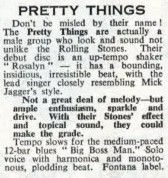
Don’t be misled by their name! The Pretty Things are actually a male group who look and sound not unlike the Rolling Stones. Their debut disc is an up-tempo shaker “Rosalyn”—it has a bounding, insidious, irresistible beat, with the lead singer closely resembling Mick Jagger’s style.
Not a great deal of melody—but ample enthusiasm, sparkle and drive. With their Stones’ effect and topical sound, they could make the grade.
Tempo slows for the medium-paced 12-bar blues “Big Boss Man.” Solo voice with harmonica and monotonous, plodding beat. Fontana label.
NME, 8 mai 1964

THE PRETTY THINGS—Rosalyn; Big Boss Man (Fontana TF 469). ★★★ — This quintet’s got a lot of support going for it. Remains to be seen whether The Pretty Things are not too like The Rolling Stones.
Disc, 9 mai 1964

THE PRETTY THINGS: Rosalyn; Big Boss Man (Fontana TF 469)
Record Mirror, 9 mai 1964
Bo Diddley beat, wild vocal, good song, but maybe a little too confused for the charts.
Au Royaume-Uni, Rosalyn est restée cinq semaines dans le Top 50 des meilleures ventes établi par le magazine Record Retailer, avec un pic à la 41e place. Elle fait mieux dans le classement rival de Melody Maker où elle atteint le numéro 36, et dans celui de Disc, un Top 30 où elle ne figure qu’une seule semaine à la vingt-neuvième position. Elle n’entre pas dans le classement du NME.
| Date | Position (Record Retailer) | Position (Melody Maker) | Position (Disc) |
|---|---|---|---|
| 30 mai 1964 | — | 47 | — |
| 6 juin 1964 | — | 42 | — |
| 13 juin 1964 | — | — | — |
| 20 juin 1964 | 46 | 43 | 29 |
| 27 juin 1964 | 47 | 40 | — |
| 4 juillet 1964 | 41 | 36 | — |
| 11 juillet 1964 | 44 | 38 | — |
| 18 juillet 1964 | 48 | 45 | — |
| 25 juillet 1964 | — | 49 | — |
| source | source | source |
Single suivant : Don’t Bring Me Down / We’ll Be Together →